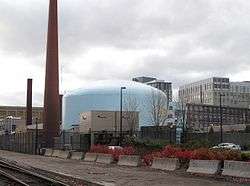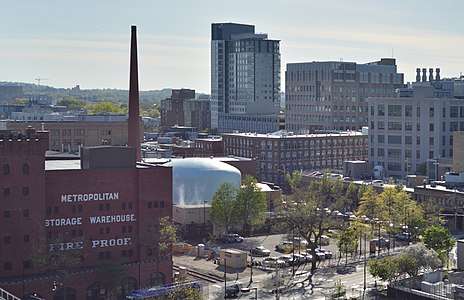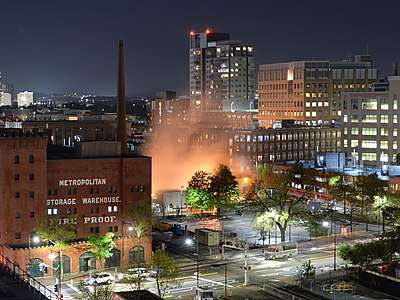MIT Nuclear Research Reactor
The MIT Nuclear Research Reactor (MITR) serves the research purposes of the Massachusetts Institute of Technology. It is a tank-type 6 MW reactor that is moderated and cooled by light water and uses heavy water as a reflector. It is the second largest university based research reactor in the U.S. (after the University of Missouri Research Reactor Center) and has been in operation since 1958.[1] It is the fourth-oldest operating reactor in the country.[2]
| MITR-II | |
|---|---|
 MIT Nuclear Reactor Laboratory in Cambridge, Massachusetts, with Tower Tech cooling tower in the foreground | |
 Location of MITR-II | |
| Operating Institution | Massachusetts Institute of Technology |
| Location | Cambridge, Massachusetts |
| Coordinates | 42°21′37″N 71°05′47″W |
| Type | tank |
| Power | 6 MW (thermal) |
| Construction and Upkeep | |
| Construction Cost | $3 million USD |
| Construction Began | 1956 June |
| First Criticality | 1958 July |
| Annual Upkeep Cost | $2.5 million USD |
| Staff | 36 |
| Operators | 15 |
| Refuel Frequency | 3-4 months |
| Technical Specifications | |
| Max Thermal Flux | 7.00E+13 n/cm^2-s |
| Max Fast Flux | 1.70E+14 n/cm^2-s |
| Fuel Type | plate type (24 to 27x) |
| Cooling | light water |
| Neutron Moderator | light water |
| Neutron Reflector | heavy water, graphite |
| Control Rods | boron & stainless steel (6x) aluminum rod with cadmium wrap (1) |
| Cladding Material | aluminum alloy |
Technical specifications
The MITR-II design uses finned plate-type fuel arranged in a hexagonal pattern of rhomboid fuel assemblies. Power is controlled by 6 manual boron-stainless steel blade-type control rods and one aluminum with cadmium control rod which can be placed on automatic control. Light water flows upwards through the core and a tank of heavy water surrounds the core. A wall of dense concrete that serves as shielding surrounds the tank of heavy water. The maximum coolant temperature is 55 degrees Celsius (131 degrees Fahrenheit). The light water and heavy water are cooled using forced circulation through heat exchangers to a secondary coolant system. The heat from the reactor is ultimately dissipated to the atmosphere via the secondary cooling system using two modular Tower Tech cooling towers – model TTXL-081950;.[3]
The reactor uses highly enriched uranium fuel, in the form of uranium-aluminum cermet with aluminum cladding.
Refueling takes place 3 to 4 times every year. A single refueling consists of rearranging the assemblies in the core or a combination of rearranging and replacement of old assemblies with new ones. This is more frequent than both nuclear power plants, which may go 17 to 23 months between refueling outages when they rearrange the entire core and replace 1/3 to 1/2 of the core, and most research reactors (particularly university reactors), many of which go decades without refueling due to the high energy density of nuclear fuel and infrequent use at high power levels.
Uses
The MITR research program encompasses most aspects of neutron science and engineering including nuclear medicine. Some of these activities are:
- Neutron activation analysis for the identification of trace elements and isotope ratios in geological specimens
- Fission engineering
- Materials testing
- Training
- Neutron transmutation doping of silicon
The MITR is one of only six facilities in the world that was engaged in patient trials for the use of boron neutron capture therapy (BNCT) to treat both brain tumors and skin cancer. The MITR fission converter beam is the first to be designed for BNCT. The facility no longer conducts BNCT trials.
Gallery
 MITR, along with the Metropolitan Storage Warehouse, viewed from MIT Building 37.
MITR, along with the Metropolitan Storage Warehouse, viewed from MIT Building 37. Night time view from the same location. Fog produced by the cooling towers is brightly illuminated by floodlights.
Night time view from the same location. Fog produced by the cooling towers is brightly illuminated by floodlights._04.jpg) Close up view of the reactor.
Close up view of the reactor.
References
- Cambridge evaluates MIT's nuclear reactor – The Tech
- "IAEA Research Reactors Database". Archived from the original on 2008-05-16. Retrieved 2008-06-11.
- unit placard
- Perez, Pedro B. (2000). "University Research Reactors: Contributing to the National Scientific and Engineering Infrastructure from 1953 to 2000 and Beyond". National Organization of Test, Research and Training Reactors. Archived from the original on 2007-07-01. Retrieved 2007-03-31.
- K J Riley; P J Binns; O K Harling (2003). "Performance characteristics of the MIT fission converter based epithermal neutron beam". Physics in Medicine and Biology. 48 (7): 943–58. doi:10.1088/0031-9155/48/7/310. PMID 12701897.
- "Research Reactor Details – MITR-II Mass. Inst. Tech". Retrieved 2008-06-11.
- MITR Staff, Safety Analysis Report for the MIT Research Reactor (MITR-II), MITNE-15, Nuclear Engineering Department, Massachusetts Institute of Technology, Oct. 1970.
